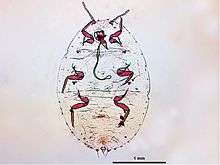Dysmicoccus brevipes
| Dysmicoccus brevipes | |
|---|---|
 | |
| Scientific classification | |
| Kingdom: | Animalia |
| Phylum: | Arthropoda |
| Class: | Insecta |
| Order: | Hemiptera |
| Family: | Pseudococcidae |
| Genus: | Dysmicoccus |
| Species: | D. brevipes |
| Binomial name | |
| Dysmicoccus brevipes Cockerell, 1893 | |
Dysmicoccus brevipes is a mealybug. The scientific name was published for the first time by Theodore Dru Alison Cockerell in 1893. The species is known to live as a parasite at species from the genus Ananas, citrus trees and coffee plants.
Characteristics
Dysmicoccus brevipes has a pink to pink-orange coloured body. The body's shape varies from round till oval and it is between the 2.3 and 3.0 millimetres long. The species is viviparous.
Female examples remain a larva for an average of 56 days but the range varies from 31 till 80 days. When the larva are fully grown – which takes an average of 96 days – they produce an offspring consisting of 234 larva average in a time span of 25 days. The larva itself have a flat and hairy body and they change their skin circa three times during the period they are a larva. They remain a larva for an average of 34 days.
Distribution
Dysmicoccus brevipes can be found in a wide variety of regions. It has been found in Hawaii, the Pacific, Central and South America, Australia and Africa.
References
- Mau, Ronald F.L.; Kessing, Jayma L. Martin (2007). "Pineapple Mealybug". extento.hawaii.edu. Department of Entomology, Honolulu, Hawaii. Retrieved 12 November 2015.
- Buamas, Chamaiporn (2011). "Pineapple mealybug (Dysmicoccus brevipes )". Padil. Thailand Biosecurity Center. Retrieved 12 November 2015.